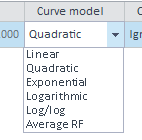Hello,
In the technical documentation for ChemStation I have found a section which is of my question

Please take a look
I need a formula to calculate the % in my samples
Hello,
In the technical documentation for ChemStation I have found a section which is of my question

Please take a look
I need a formula to calculate the % in my samples
Hi Alex1960
Have a look at the next page in the documentation in the section describing ESTD.

If you include a sample amount in the sequence table and choose ESTD% as the calibration settings section of Specify Report.
Chemstation will calculate the mass percentage by taking the measured amount, divided by the sample amount and multiplied by 100.
/Andy
Hi Alex1960
Have a look at the next page in the documentation in the section describing ESTD.

If you include a sample amount in the sequence table and choose ESTD% as the calibration settings section of Specify Report.
Chemstation will calculate the mass percentage by taking the measured amount, divided by the sample amount and multiplied by 100.
/Andy
Hi Andy,
Thank you for the attention to my question!Happy New Year!!!
As you may see, in the formula Agilent has ResponseX as a numerator and as a denumerator. This is meaningless (from math point of view) equation.
Strait calculation would give absolutely incorrect result. What is the point to calculate amount of a sample multiplied by dilution factor and multiplier. In this case we do not need standards at all. Please take a closer look at the equation! When you are working with report, you did not see the formula (real calculations) behind.
Would you please verify (or provide) exact calculation formulas for me?
Thank you
Alex
HI Alex,
I see what you're saying now. I think the document should have RF=Amount/Response where this is determined from standards. For each calibration, Chemstation calculates the equation of the line of best fit according to the calibration settings. This equation is then used to calculate the amount of analyte, which is then corrected using multipliers and dilution factors. Since each calibration is unique, I can't provide you with an exact equation. For linear calibrations, the line would have the equation response = a*amount + b, so given a response for a sample, amount can easily be calculated.
Does that make more sense?
/Andy
Alex,
The formula may be a little unclear but it is correct. When the RF is calculated from the calibration it is expressed as the amount of the compound over the area. So lets say your compound in the sample is 100 area counts, the software uses that value and the calibration values to calculate the RF for that compound. So foe example that could be expressed as 500ppm / 100 area counts. If you use that RF in the calculation the unknown response can be cancelled as shown in the equations. Now if you output on a report the RF for a calculated peak it will be simplified so in this example it would be 5. The key is the RF is calculate from the calibration based on that response.
Marty Adams
Martin,
So, formula should be Response(st)*(Amount(x)/Response(x))*M*D
Is this correct?
Thanks in advance
Alex,
The formula is as shown in the manual below where the RFx is calculated from the calibration and expressed as amount(x)/response(x). I cannot say what that calculation is for your method. It could be a simple average response factor calculation, linear formula, or several others.
Marty Adams

